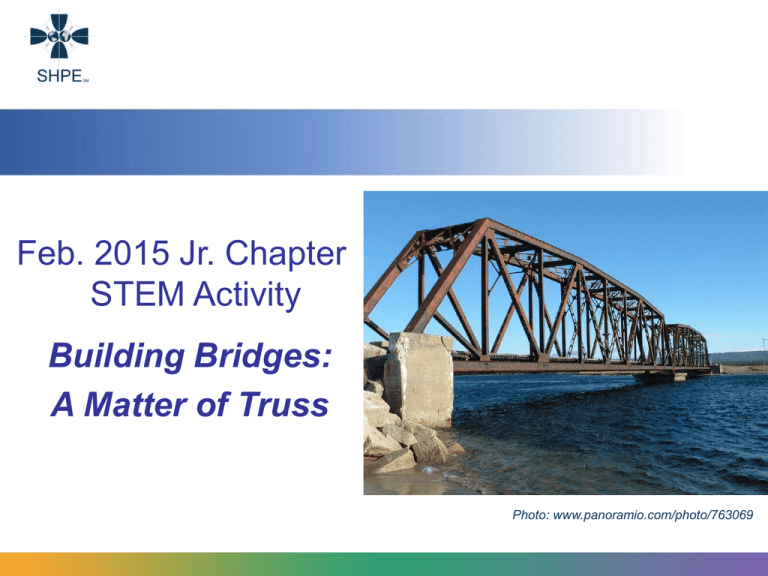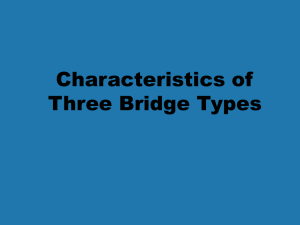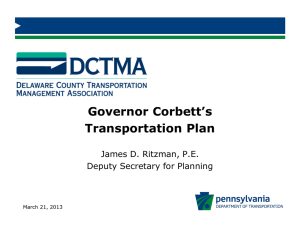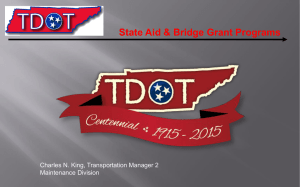Building Bridges - SHPE Foundation
advertisement

Feb. 2015 Jr. Chapter STEM Activity Building Bridges: A Matter of Truss Photo: www.panoramio.com/photo/763069 Some simple advice: • Be prepared. Test-drive the activity beforehand. • Have all the required materials on hand. • Keep students on track. • Keep an eye on the clock and follow the time frame. • Be flexible and creative. • Have fun! Building Bridges: A Matter of Truss Goal: Students consider bridge design and learn about approaches to bridge building, and then work in teams to construct a truss bridge in accordance with a given set of parameters (length, load, and budget). Engineering/STEM areas: Civil engineering, physics Learning objectives • Understand forces operating on bridges • Understand structural factors that lend stability to bridges • Understand some factors that have led to bridge collapses • Learn about different types of bridges • Understand the engineering process of prototyping, trial and error Building Bridges: A Matter of Truss Time: 60 mins Suggested group size: 2-3 depending on number of students Materials: • • • Student Resource Sheets (in lesson) Student Worksheets (in lesson) For each pair or team: • 100 craft sticks (popsicle sticks) • Cable ties (about 20 per group) • Glue gun and glue sticks or quick-drying glue • Cardboard or newspaper to protect work surface • A hanging weight or a .5L bottle filled with water • Nylon cord, about 3 feet per group • Desks or chairs to suspend bridges across Building Bridges: A Matter of Truss Before the activity: • Read through both the student and instructor resources so you have the background information • Gather all the necessary materials. Assemble sets of materials for each group • Make enough copies of the Student Resource so that each student has one • Make one copy of the Student Worksheet per group, plus a few extras • Devise a way to show the video of the Tacoma Narrows bridge. If not possible, print out copies of the bridge photos in the Instructor Resource • Make your own drawing of a bridge or design a small section of bridge that use can use to talk about different kinds of forces acting on a bridge • View the 3-min video of bridge construction at: http://www.instructables.com/id/Teach-Engineering-Truss-Bridges/ Building Bridges: A Matter of Truss Forces on bridges Many different forces are at work on a bridge. Here are some of the most important ones: Stress is the amount of force on a bridge (or other object). Strain is the amount the bridge or object is deformed as a result of the stress. The force (stress) of gravity pulls down on the bed of a bridge, causing a strain (deformation) that results in the bridge sagging slightly. Tension and compression are forces that occur in tandem, acting on the bridge as a result of the force of gravity. Tension is the force pulling on the bottom of the roadbed under strain. Compression is the force on the top surface of that same roadbed. Tension lengthens the roadbed and compression shortens it. An engineer must design a bridge so that it distributes these two forces throughout the bridge and particularly to the strongest areas. Building Bridges: A Matter of Truss Types of bridges There are many variations on bridges, but most of them fall into four broad categories: Beam bridges are the most basic type, some kind of rigid horizontal plane on top of (at least) two vertical supports. The supports bear much of the downward force. The thicker the horizontal surface, the more weight the bridge can bear. But beam bridges can’t span great distances because they don’t distribute tension and compression well. Truss bridges are like beam bridges with reinforcements. Trusses are structural elements that involve beams secured together in triangles. A truss dissipates the load on a bridge, allowing the bridge to withstand more force overall. There are thousands of variations on truss bridges, and almost every bridge you see will involve a truss of some sort. The truss bridges you see are likely to have been built in the last 100 years, but there are many bridges in the world much older than that. pbs.org and micro-scale.com/ Building Bridges: A Matter of Truss Arch bridges are the oldest type of bridge. The Arkadiko bridge in Greece is over 3,000 years old and still in use. Arch bridges distribute the forces of compression across a series of blocks that make up the arch. The compression force is so strong that the arch will stay standing even without any mortar between the building stones. Some modern bridges incorporate both an arch above the roadbed and a truss below. Suspension bridges are literally suspended from two towers using cables. The ends of such a bridge are anchored with weights. A suspension bridge redistributes force so that the towers are under compression and the suspension cables are under tension. Suspension bridges are not only the most efficient design for distributing force but they are also beautiful. The downside is that suspension bridges are expensive. So the world’s longest bridges are truss and beam bridges. Wikipedia.com (both images) Building Bridges: A Matter of Truss Activity procedure • • • • • Ask students to describe some features designed to make bridges stable. Then ask them if they recall any stories of bridges collapsing, Explain that bridges don’t collapse often, but when they do, it’s usually a spectacle. Show the video or pass around the images of the Tacoma Narrows bridge. Ask students to theorize about what made the bridge unstable. Tell students that engineers have to consider many factors when designing a bridge. If one of these is left out or miscalculated, the effect can be devastating. Go through the information in the Student Resource and make sure students understand the different types of bridges and the forces acting on bridges. The most important factor we tend to think of is force. Tell students they’ll be constructing a bridge to meet certain parameters. Group students in pairs or trios and make sure each group has a set of materials. Go over the bridge-building instructions and truss patterns and answer any questions. Tell students they have 5-10 minutes to sketch a bridge design. After that time has passed, tell them they have 15 minutes to construct their bridges. Building Bridges: A Matter of Truss Activity procedure (cont’d) • Next, students should take 5 minutes to test their bridges. Tell them to be sure to note on their drawings where the bridges seem weakest and what seems to be happening to the structure in those places. • Tell students to write and/or draw suggestions about how to strengthen the weakest spots in their bridge. • To end the lesson, ask each group whether their bridge held the weight and to describe improvements they would make to strengthen it. Building Bridges: A Matter of Truss Designing the bridge There are many approaches students can take. They can begin with these patterns, and should keep in mind that they have a budget of 100 popsicle sticks, including the bottom of the bridge. Instructables.com and Deborah Elliot, La Costa Canyon high school. Building Bridges: A Matter of Truss Constructing the bridge It’s advisable to build the sides first, and then the bottom (and the top if there will be four sides). Use glue to attach the craft sticks together for each piece. Once the main pieces are constructed, use zip or cable ties to secure the parts together. WYE_Lance on Instructables.com Building Bridges: A Matter of Truss Testing the bridge Set the bridge between two chair or other surfaces so that it bridges the two. Test the bridge by putting the nylon cord through both ends, tying a knot, and laying the water bottle or weight across the loops of slack. This arrangement distributes the weight more evenly across the bridge. WYE_Lance on Instructables.com Building Bridges: A Matter of Truss Assessment • Each group should describe the following to other students: • Whether their design held the weight tested on it • Whether it was difficult to design and work within their budget • What they noticed as they added stress by pushing down on the weight and an explanation for it that includes considering the forces acting on the bridge • How they would strengthen the bridge Building Bridges: A Matter of Truss Vocabulary • Compression -- The force on the top surface of a bridge bed as gravity pulls downward • Strain – The amount a material is deformed due to stress on it • Stress – Force per unit area on an object or material • Tension – The force on the undersurface of a bridge bed as gravity pulls downward • Truss – A structural frame that contains material forming a series of triangles in a single plane Building Bridges: A Matter of Truss Extensions • • Discuss bridge collapses and why they happened. Have students propose solutions or fixes to the bridges that might have prevented the collapse. They can learn more with this online interactive: http://www.pbs.org/wgbh/nova/tech/bridge-collapse.html Explore new engineering approaches to “smart bridges,” which can communicate that they’re having structural problems. See a video here, that includes references to nanotechnology and materials (a way to build on the previous month’s activity): http://www.pbs.org/wgbh/nova/tech/smartbridges.html Building Bridges: A Matter of Truss Teaching tips • Take the reins on dividing the class into student groups (rather than letting students decide). If you know your students, try to be sure that each group has a balance of personalities, with a mix of outgoing and more introverted students. • Circulate around the classroom as students are working and be sure to keep them on track, answer questions, and encourage students who are less assertive. • Some groups will be more active and will immediately dive into design, and others will be more reticent. Show groups your bridge or drawing to give them inspiration. • Encourage students to think about the design of bridges they’ve seen or are familiar with. What elements make the bridge work functionally? What elements make it work aesthetically? Building Bridges: A Matter of Truss Takeaways: • Bridges are a complex engineering challenge: Load, stress, environmental elements, and earthquakes all become part of the engineering challenge • Any engineering project needs to be designed with parameters in mind: The design for a bridge must not only be functional, but it must be possible to build the bridge with only the resources at hand. • Forces on an object can be redistributed with engineering design: An important job of an engineer is to understand force and how structures can be designed to make them withstand the forces they will encounter. Building Bridges: A Matter of Truss Resources and bibliography: Stable and Unstable Structures http://www.discoveryeducation.com/teachers/free-lesson-plans/stable-and-unstablestructures.cfm Truss Bridges http://www.instructables.com/id/Teach-Engineering-Truss-Bridges/ Building Big: Bridges http://www.pbs.org/wgbh/nova/education/ideas/0000_bbbridge.html PhysicsQuest: Bridges http://physicsquest.homestead.com/bridge.html Build a Bridge http://www.pbs.org/wgbh/nova/tech/build-bridge-p3.html Building Bridges: A Matter of Truss Questions about the activity? Contact Robin Marks Discovery Street Science discoverystreetscience@gmail.com







